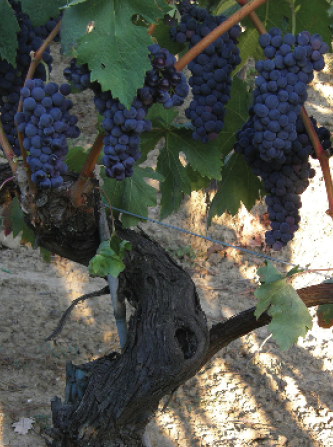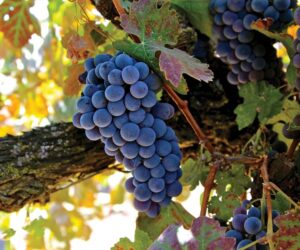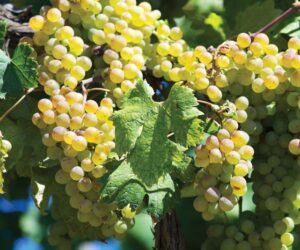 When we think of the noble grapes in the world, often what first comes to mind are the traditional noble varieties such as Chardonnay, Sauvignon Blanc, Riesling, Pinot Noir, Merlot and the grandest in some people’s eyes, Cabernet Sauvignon. The term “noble” is referred to as the traditional varieties from the best regions that are made into the best wines. This is sort of a regional boasting and is part of the mystique we all experience in our love for all things wine. As in beauty, the “nobility” of grapes and wine is in the eye of the beholder, and subsequently, other regions prominently boast their own noble varieties. Of the traditional varieties grown outside of France, there’s Cabernet from Napa, Sauvignon Blanc from New Zealand, Pinot Noir from Oregon, and Merlot from Washington State. Of the “non-noble,” if you will, the Sierra Foothills have its Zinfandel, Missouri has its Norton, and Australia has its Shiraz. But let’s travel just a little bit to the south and west of France to look at another very deserving European noble grape, and that is the Spanish grape, Tempranillo. Tempranillo is the predominant black grape variety from the northern wine region of Spain we know as the Rioja, and other regions of the Iberian Peninsula.
When we think of the noble grapes in the world, often what first comes to mind are the traditional noble varieties such as Chardonnay, Sauvignon Blanc, Riesling, Pinot Noir, Merlot and the grandest in some people’s eyes, Cabernet Sauvignon. The term “noble” is referred to as the traditional varieties from the best regions that are made into the best wines. This is sort of a regional boasting and is part of the mystique we all experience in our love for all things wine. As in beauty, the “nobility” of grapes and wine is in the eye of the beholder, and subsequently, other regions prominently boast their own noble varieties. Of the traditional varieties grown outside of France, there’s Cabernet from Napa, Sauvignon Blanc from New Zealand, Pinot Noir from Oregon, and Merlot from Washington State. Of the “non-noble,” if you will, the Sierra Foothills have its Zinfandel, Missouri has its Norton, and Australia has its Shiraz. But let’s travel just a little bit to the south and west of France to look at another very deserving European noble grape, and that is the Spanish grape, Tempranillo. Tempranillo is the predominant black grape variety from the northern wine region of Spain we know as the Rioja, and other regions of the Iberian Peninsula.
While in North America, where we are usually only familiar with the common name Tempranillo, the grape actually has over 50 synonyms, but it is the common name that typifies the grape. Temprano is the Spanish word for “early.” Thus Tempranillo, translated from Spanish, describes the grape that is a “little early.” This is referring to the ripening characteristics as compared to other red varieties grown in the northern regions of Spain where it is thought to have originated. In the Ribero del Duero it is referred to as Tinto Fino, where downstream on the Portuguese section of the river, it is known as Tinta Roriz. The grape came to California as Valdepenas in the early 20th century. The many variations of the name preceded by the word Tinta followed by a local or descriptive reference, like Tinta Santiago, Tinto de Madrid or Tinta de Toro. But then again, there are those names that are something completely different like Cencibel or Ull de Liebre, which translates to “eye of the hare,” and Aragones of the Alentejo region. This is just the tip of the iceberg for synonyms! Alas, the grape is very widespread, and regional tradition has dictated it local names. We can be fortunate that in North America it will be marketed as its most familiar name.
Before we get to talking about the grape itself and the winemaking, let’s look at the regions and the climates where these grapes are found. As I previously mentioned, the grape is thought to have originated in the Rioja region of northern Spain, but the grape is grown extensively throughout Europe’s Iberian Peninsula, the Ribero del Duero and the Navarra. Further to the west, and downsteam of the Duero River, in Portugal, the grape is grown in the Douro River region where there is a maritime influence. Geographically, the Douro River is the same river as the Duero. And then there’s the hot Alentejo region of Portugal, which is like the Rioja Baja. In general, the climate in Spain is warm to hot during the day and, depending on the altitude, the nights can be warm or quite cool. The grape does best in the typical Mediterranean climate regions. These are characterized by 12-20 inches (30-50 cm) of rain annually, with most of that moisture falling in a timespan of a few months. The winters in Northern Spain are cold, much colder than the typical Mediterranean climate, which shows the grape’s versatility as to where it can grow. The Rioja region is primarily a plateau at about 1,500 feet in elevation. The Rioja Alta and Rioja Alavesa are at the highest elevations and will experience cool nights. The Rioja Baja, as the name might imply, is the warmest region, hot and dry, with less of an influence on night cooling.
The fruit’s characteristics at harvest are typical of the regions in which it was grown. The best wines are those where the days are hot and the nights are cool. Here in Davis, California, we typically experience a hot, dry climate like the Rioja Baja or the Alentejo, thus our wines tend to be higher in alcohol, and typically low in acid, while those of the Rioja Alta are lower in alcohol and higher in acidity. You will also find plantings in South America, Australia, Canada, Mexico and the United States — mostly in California, but also in Texas.
The winemaking for Tempranillo is quite variable based on the region in which it is grown. As you can probably surmise, the many regions will bring about many wine styles. It is made as a dry red, as in the Rioja, or it becomes a significant component in Port production of the Douro, made from those synonyms, Tinta Roriz, Aldepenas, Aragones or Aragonêz. For dry red wines, beginning Brix levels should be 24-26 °B. The ideal beginning acidity is adjusted (or not) to somewhere around 0.65-0.75% to target for a finished acidity of around 0.55% after the malolactic conversion. The grapes are crushed and destemmed and generally follow the traditional red winemaking regimen of pressing when nearly dry or dry. Port wines are different in that the grapes are pressed prior to fortification with neutral grape spirits to arrest the fermentation.
The grape characteristics at harvest also challenge the winemakers. The diverse climates where the grape is grown give some diverse must characteristics. Low acidity levels are common to the grape from the warmer regions. These low acidity levels are the result of the vines’ propensity to take up potassium from the soil as the grapes mature. The destination for the potassium? You got it . . . the berry. And because one ion has to be exchanged for another in this process, the berry loses a proton, thus increasing the pH. Historically, the winemakers blended the higher acid wines from Rioja Alta and Rioja Alavesa with those from the Rioja Baja. You will also see it blended with Grenache, what the Spaniards refer to as Garnacha Tinta, or other red grapes such as Graciano and Mazuelo.
For those of us who do not have the luxury of blending the finished wines, at least in the United States, acidity adjustments are generally made using tartaric acid. The challenge to the home winemaker is finding the right balance of acid. I recommend a range of acid values for a Tempranillo wine, but this is just a target value. I firmly believe that tasting the juice or wine is the most important component to making additions.
At an industry tasting of Rioja wines last year in San Francisco, I was treated to many different styles of Tempranillo. Some of the wines were not aged in oak at all, and very young. Others liberally expressed a French oak influence. And then there were those examples that used American oak. My personal favorites were the contrasting styles between the wines aged in French oak and those that did no go through an oak aging. The French oak lends a creamy vanilla texture in the mouth, but not so overpowering to overcome the fruit characteristics, whereas the un-oaked wines were simple, but nonetheless fruity and seemed like they would be very refreshing on a hot summer day. The American oak styles were in direct contrast to the aforementioned French oak style. They were a bit more tannic, and probably needed more time in the bottle to tame the tannins. With the high prices fetched for French oak, the use of American oak has increased, and many wineries now use both types to carve out the final blend.
The best Tempranillo wines can be very age-worthy, although there is a tendency to release them young as with other red wines. Traditionally they were aged four to eight years. As with any great wine region, they have their variations and their own set of rules. Those labeled joven are the youngest, having spent less than a year in oak. Crianza indicates that the wine was aged for two years, with at least one year in oak, Rioja riserva has been aged for three years with at least one year in oak. And finally, Rioja gran riserva, has at least two years in the barrel, and at least three years in the bottle for a minimum of five years. These are the best wines and are not made every vintage.
At a glance, it seems as though Tempranillo is just another one of those obscure varieties making its way in the marketplace. For the most part, it is only labeled as the varietal in the New World given the illusion that it is not a popular grape and undeserving as the noble grape status. Noble is defined as, “admirable in dignity, manner of expression, execution, or composition” and when you add it all up, Tempranillo is all that, albeit elusive.
Tempranillo Recipe
(yield: 5 gal/19 L)
Ingredients
• 125 pounds (57 kg) Tempranillo fruit
• Distilled water
• 10% potassium metabisulfite (KMBS) solution: Weigh 10 grams of KMBS, dissolve into about 50 milliliters (mL) of distilled water. When completely dissolved, make up to 100 mL total with distilled water.
• 5 grams Premier Cuvée yeast
• 5 grams Di-ammonium Phosphate (DAP)
• 5 grams Go-Ferm
• 5 grams Fermaid K (or equivalent yeast nutrient)
Other equipment or needs
• 15-gallon (57-L) food-grade plastic bucket for fermentation.
• 5-gallon (19-L) carboy
• (1-2) 1-gallon (3.8-L) jugs
• Racking hoses
• Destemmer/crusher
• Wine press
• Inert Gas (nitrogen, argon or carbon dioxide)
• Ability to maintain a fermentation temperature of 85-90 °F (30-32 °C).
• Thermometer capable of measuring between 40-110 °F (4-43 °C) in one degree increments.
• Pipettes with the ability to add in increments of 1 milliliter
• Clinitest® tablets.
• Tartaric acid
Step by step
1. Clean and sanitize all your winemaking tools and equipment.
2. Crush and destem the grapes.Transfer the must or juice to your fermenter.
3. During the transfer, add 15 mL of 10% KMBS solution (This addition is the equivalent of 50 ppm SO2). Mix the solution well.
4. Take a sample to test for Brix, acidity and pH. Keep the results handy. We’ll take this up later.
5. Layer the headspace with inert gas and keep covered. Keep in a cool place overnight.
6. The next day, dissolve the DAP in as little distilled water required to completely go into solution (usually ~ 20 mL). Add the solution to must or juice and mix well.
7. Go back to those lab results you took yesterday (step 4). Typical Brix for this style is 24-25 °B. Typical acid levels will be 0.65-0.70%. Adjust the levels as necessary.
8. Prepare yeast. Heat about 50 mL distilled water to 108 °F (42 °C). Mix the Go-Ferm into the water to make a suspension. Take the temperature. Pitch the yeast when the suspension is 104 °F (40 °C). Sprinkle the yeast on the surface and gently mix so that no clumps exist. Let sit for 15 minutes undisturbed. Measure the temperature of the yeast suspension and the juice. You do not want to add the yeast to your cool juice if the temperature difference exceeds 15 °F (8 °C). To avoid temperature shock, you should acclimate your yeast by taking about 10 mL of the must juice and adding it to the yeast suspension. Wait 15 minutes and measure the temperature again. Do this until you are within the specified temperature range. Do not let the yeast sit in the original water suspension for longer than 20 minutes. When the yeast is ready, add it to the fermenter and mix.
9. You should see signs of fermentation within one to two days. This will appear as some foaming on the must surface and it will appear that the berries are rising out of the medium. This is referred to as the “cap rise.”
10. Push the grapes back into the juice to promote color, and tannin extraction. This is called “punching down” and this should be done three times per day. Use a sanitized utensil.
11. Monitor the Brix and temperature twice daily during peak fermentation (10-21 °Brix). You want to keep the temperature between 85 °F (29 °C) and 90 °F (32 °C).
12. At about 19 °Brix, sprinkle in the Fermaid K and punchdown.
13. When the Brix reaches 0 °Brix (about 5–7 days), transfer the must to your press and press the cake dry. Keep the free run wine separate from the press portion for now and label your vessels.
14. Transfer the wine to your carboys or 1-gallon (3.8-L) jugs. Your press fraction may only be a gallon/liter or two. Make sure you do not have any headspace. Place an airlock on the vessel(s). Label the vessels.
15. Inoculate with your malolactic (ML) bacteria. Check the manufacturer’s instructions on how to prepare and inoculate. Cover the tops with a airlock to allow CO2 to escape.
16. Monitor the ML fermentation using a thin layer chromatography assay. Follow the instructions included in the kit.
17. When the ML is complete, measure the residual sugar using the Clinitest®. Make adjustments if necessary.
18. Add 2 mL of fresh KMBS (10%) solution per gallon of wine. This is the equivalent to ~40 ppm addition.
19. Place the wine in a cool place to settle.
20. Consider adding some French or American oak chips to your press fractions. Do not treat the entire lot of wine.
21. After two weeks, test for pH and SO2. Adjust the SO2 as necessary to attain 0.8 ppm molecular SO2. Check the SO2 in another two weeks and adjust. Once the free SO2 is adjusted, maintain at this level. You’ll just need to check every two months or so, and before racking.
22. Rack the wine clean twice over 8-12 months to clarify. Fining and/or filtration are generally not needed if SO2 are maintained and there are no surface films or indications of subsequent fermentations.
23. Once the wine is cleared (after about 12 months), it is almost time to bottle. Make the project fun by having a blending party to integrate the press fraction back into the free run.
24. Now it is time to bottle. Maintain sanitary conditions while bottling. 25. After bottling, you will need to periodically check your work as the wine ages. You can do this alone, however, evaulation is best done by opening a bottle from time to time to enjoy with friends.






